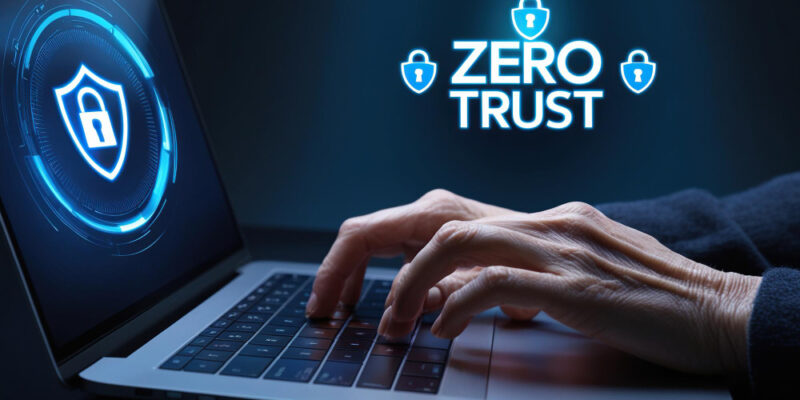
In today’s digital landscape, the number of cyber threats is increasing, with attacks becoming more sophisticated and widespread. As organizations, especially those in critical industries like banking, face escalating cyber risks, traditional security models are proving inadequate.
Enter Zero Trust Security, a modern approach to cybersecurity that fundamentally shifts how we think about securing systems, data, and networks.
Zero Trust operates on the principle that no user or system, whether inside or outside the organization’s network, should be trusted by default. Instead, every access request must be continuously verified. This concept is especially relevant in sectors such as finance, where data security in the banking industry is a top priority. Banks handle sensitive customer information and financial data, making them prime targets for cybercriminals.
In this blog, we’ll explore what Zero Trust Security is, the core principles that define it, and how organizations can implement it effectively.
What is Zero Trust Security?
Zero Trust Security is a cybersecurity framework that shifts away from the traditional notion of trusting users within a network. Historically, once inside a network, users could access various resources with minimal verification. Zero Trust changes this by enforcing strict identity verification for every user and device attempting to access network resources, regardless of their location.
The approach assumes that threats could come from anywhere, even inside the network, and therefore implements security checks at every point of access.
The Principles of Zero Trust Security
- Continuous Verification: Never Trust, Always Verify The core of Zero Trust lies in the idea that no entity—whether human, machine, or system—should ever be fully trusted. Even after authentication, access is continually verified through a combination of factors such as identity, location, behavior, and device compliance.
This means that traditional firewalls and network perimeters are no longer the sole gatekeepers of data and system access. Organizations must implement strong authentication protocols like multi-factor authentication (MFA) and use technologies such as biometrics and behavior analytics to ensure ongoing trustworthiness.
- Principle of Least Privilege Another vital element of Zero Trust is the Principle of Least Privilege (PoLP). This ensures that users are granted the minimum levels of access necessary to perform their jobs. For instance, a bank teller should not have access to the institution’s full database of customer records, just the information required to serve their clients.
Implementing PoLP reduces the attack surface and limits potential damage in the event of a breach. In the banking sector, controlling access is crucial for protecting both customer information and financial data.
- Micro-Segmentation Micro-segmentation divides a network into smaller, isolated sections, which allows organizations to control access at more granular levels. Each segment has its own security protocols, meaning even if an attacker breaches one segment, they cannot easily move laterally across the network.
In the context of data security in the banking industry, micro-segmentation prevents unauthorized users from accessing critical systems like payment processing or personal account details.
- Assume Breach Mentality Zero Trust encourages organizations to operate under the assumption that breaches will happen, or may have already occurred. This assumption compels businesses to implement robust monitoring and incident response mechanisms. Real-time visibility and analytics help detect unusual activity and enable quick responses to potential security incidents.
Adopting an “assume breach” mentality also involves regular security assessments, penetration testing, and constant improvement of defense mechanisms.
Why is Zero Trust Security Important?
The digital transformation journey undertaken by most organizations comes with benefits like greater agility and scalability, but it also brings increased cybersecurity risks. The rise of remote work, cloud computing, and IoT devices has blurred traditional network boundaries, making it difficult to trust or protect the entire perimeter effectively.
A Zero Trust model is necessary to combat the increasing threat landscape because:
- It protects against insider threats.
- It addresses the vulnerabilities created by an evolving and decentralized IT ecosystem.
- It enables organizations to apply stronger, more granular security measures without compromising performance.
For sectors like finance, where breaches can lead to catastrophic financial loss and reputational damage, implementing Zero Trust can offer the comprehensive protection needed to safeguard critical assets and customer data.
Extending Zero Trust to Protect Microsoft 365 Data
In addition to protecting internal networks and systems, organizations using cloud-based services like Microsoft 365 must extend Zero Trust principles to safeguard their cloud environments. As businesses increasingly rely on cloud platforms for communication, collaboration, and data storage, it becomes critical to protect Microsoft 365 data from unauthorized access and potential breaches.
By implementing Zero Trust security for Microsoft 365, organizations can ensure that access to sensitive emails, files, and documents is closely monitored and controlled, preventing both external threats and insider risks. This comprehensive approach to security is vital for protecting the integrity of cloud-based data in today’s evolving digital landscape.
Conclusion
As cyber threats continue to evolve, organizations can no longer rely on outdated security models that focus on perimeter-based protection. Zero Trust security offers a modern, comprehensive approach that addresses the challenges of today’s digital environment. Its principles of verifying explicitly, enforcing least privilege, and continuously monitoring access enable organizations to reduce risks and enhance their overall security posture.
For sectors like the banking industry, where the data security of customers is paramount, adopting Zero Trust is critical to safeguarding sensitive financial information from cyberattacks. The transition to a Zero Trust model may require a shift in mindset and investment in new technologies, but the enhanced security and protection it provides make it a necessary step in ensuring resilience in the face of modern cyber threats.











